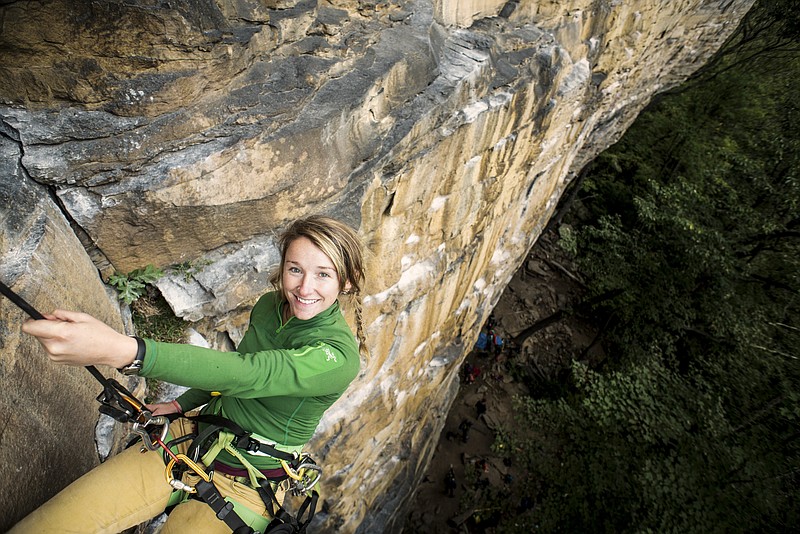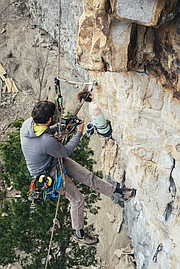Forty feet up against a sandstone wall, Rich Moore dangled from a rope, gripping his camera.
Nearby, Nathalie DuPre, also poised with a camera, perched in the top of a sycamore. The morning was blustery, and the branches beneath her undulated like ocean waves. To steady herself, DuPre pressed one foot against the adjacent rock.
From their respective angles, the two focused their shots on the climber below and held their breaths.
Filming the crux of 5.14a-grade climbing route is not easy, but Elaine Elliott, founder of Steep South, says someone has to tell these stories.
More Info
“Filling the Void: Chapter One” will premiere at the Cumberland Transit retailer shop in Nashville, Tennessee, on Friday, Sept. 26 at 7 p.m. The event will be co-hosted by Steep South and Friends of South Cumberland. The film’s local debut will take place at Rock/Creek’s North Shore location on Saturday, Sept. 28 at 6:30 p.m.Proceeds from all screenings will be donated to the Southeastern Climbers Coalition.Eventually, the film will be available to view for free on YouTube.Meanwhile, says Elliott, Chapter Two is still in the preliminary planning process. Its production, however, is contingent on sponsorships in order to compensate the crew.To learn more about Steep South and all its projects, visit steepsouth.com.
Launched in 2017, Steep South is a media company dedicated to climbing in the Southeast. The project began as an Instagram account in which Elliott reposted photos taken by regional climbers throughout Southeastern states. Within two years, the page had amassed 5,500 followers.
"I had just wanted to see if there was an audience," Elliott says. "I was getting frustrated with the lack of Southeast climbing in the media. In magazines and on websites you just see the same Western crags over and over. We have amazing stories here, too. So why not create a single platform for our voice?"
From the beginning, though, her dream was for Steep South to do more than just spotlight regional climbing. She also wanted to prove that media could be a stage for stewardship. Nonprofit preservation organizations such as the Southeastern Climbers Coalition rarely have media budgets, says Elliott. "But it can be such a powerful tool in bringing awareness to projects," she insists.
The most effective way to connect climbers to conservation, Elliott decided, was through video. Early this year, she roped in Moore and DuPre, two local climbers also known for their filming and photography, to help take Steep South's mission to new heights.
Public donations are the company's only source of income, so the team all agreed to work pro bono. In March, the team of three began filming Steep South's first documentary, "Filling the Void," a 40-minute film which tells the story of Denny Cove. It was for that film that Moore and DuPre found themselves dangling above a ridge in Tennessee's South Cumberland State Park.
Located just south of Foster Falls and famous for its sport climbing, Denny Cove is a 685-acre tract of land boasting nearly 3 miles of sandstone cliff line, which remained hidden among the lush hills of the Southern Cumberland Plateau until 2010.
This helps illustrate one reason that Elliott believes Southeastern crags get less attention than their Western counterparts. "We don't have these huge white-capped mountains. Our crags are hidden by forest, waiting to be discovered," she says.
When Denny Cove was finally unearthed, climbers at once recognized its potential. Over the next five years, advocates, community leaders and state park officials worked together in an effort to purchase the property, owned by a timber company. Their goal was to turn Denny Cove into a publicly accessible rock climbing destination.
In 2016, the Southeastern Climbers Coalition, spearheading the efforts, received a grant from the Access Fund and the national climbing advocacy group's partners. The grant covered a substantial portion of Denny Cove's $1.2-million purchase price, leaving the SCC with a more manageable debt of $150,000.
That land acquisition was the largest in SCC history, but the work wasn't over. Before Denny Cove could open to the public, the walls had to be "cleaned" by route developers, an arduous process that involves removing potentially hazardous rock, dirt or vegetation along climbing routes.
Finally, in the spring of 2017, Denny Cove opened to the public, offering 150 newly polished routes.
"So many people climb there now, but I think a lot are unaware of the blood, sweat and tears that went into opening those crags," says Elliott, whose goal for the film was to help people feel more connected to Denny Cove, while reminding them that the small nonprofit still has $60,000 remaining on that $150,000 debt.
But "Filling the Void" has a second goal, too: to showcase Southeastern sandstone. The lifeblood of the film is heart-pumping footage of well-known regional climbers scaling Denny Cove's versatile walls.
One reason Denny Cove is so popular, says Moore, is that its climbing grades range from beginner to expert, appealing to all skill levels. During filming, however, the team shot only advanced routes, grades 5.10 and up, often capturing the crux, or the most difficult section of the climb.
The shoot took place over the course of three days in late March.
"From sunrise to sunset," say Moore. "We'd get up in the morning, freezing cold, and then we'd go hang in midair for the rest of the day, trying not to damage our gear."
Hauling expensive gear up and down sandstone requires utmost care, which is just one reason that filming on rock is complex. Even before shooting began, the crew had to meticulously plan when and where they would need certain equipment: mics and tripods at the bottom for interviews; cameras at the top for filming.
As Moore explains, "Once you're hanging from that rope, you're not going anywhere."
Another big challenge was video stabilization. When trying to steady a shot, "there's nothing firm to press against. You just try your best to find three points of contact – and you try not breathe. Literally, I would find myself gasping for air, trying to hold steady on the rock," Moore says.
Typically, he and DuPre would begin a shoot at the top of cliff; then they would rappel down with their gear to find the best angle, which some days meant perching in the top of a sycamore.
Climbing, the crew knew, has inherent risks - a truth which Elliott was reminded of upon purchasing film insurance, which cost Steep South twice the standard price due to the nature of the sport. But among all the logistical and physical struggles, the crew's collective motivations were greater than just movie-making.
Their passion for climbing was what had first brought them to Denny Cove, and their desire to share that transcended the effort.
Being roped in to the top of that tree was scary, DuPre says, and that's part of the reason why she loves the sport.
"[Climbing] challenges me and terrifies me, and makes me feel like king of the world," says DuPre.
Elliott remembers one evening amid the long weekend of filming. Moore and DuPre had been filming on rope since dawn. The sun was starting to set, staining the sky pink and purple. The crew had captured all the footage they needed.
"But they just couldn't turn their cameras off. We're tired, we're hungry, but none of us want to leave that crag. This is how you know what your passion is," says Elliott - who decided to add "Chapter One" to the title of Steep South's first documentary.
"We're not done yet," she says. "There are more stories to be told."

